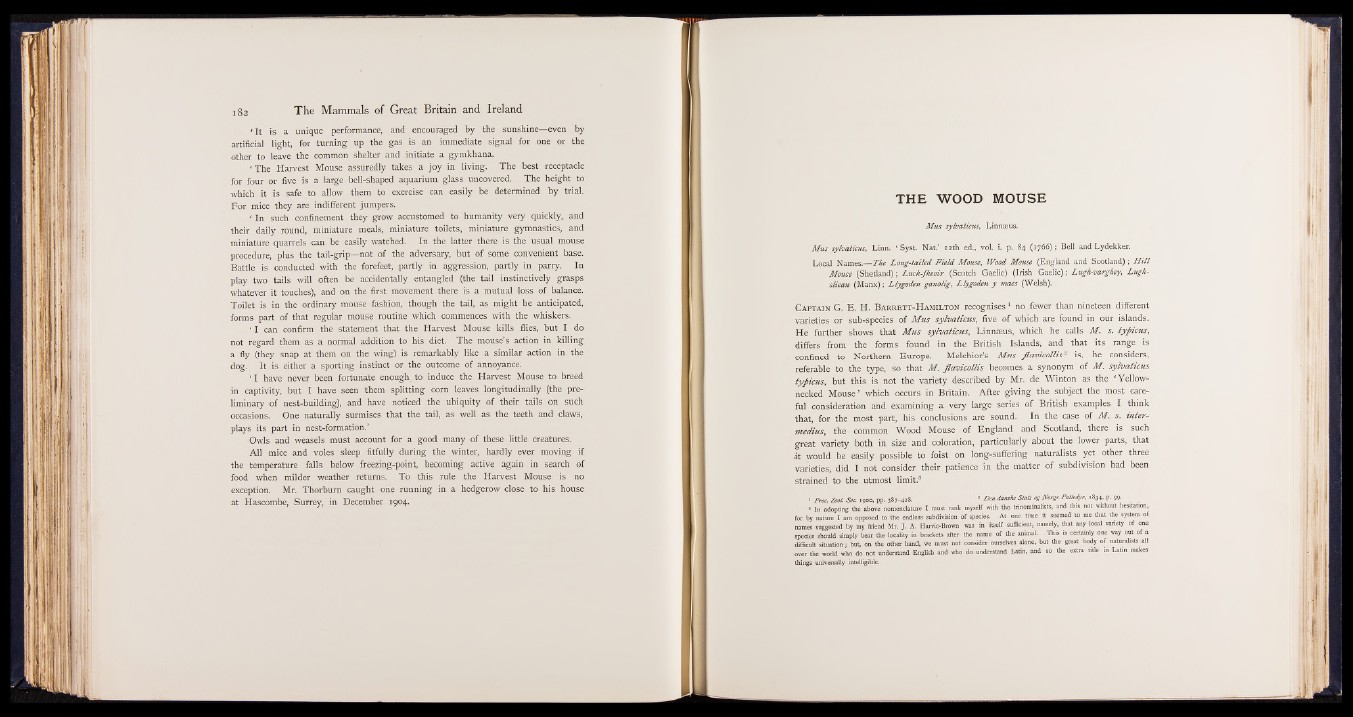
‘ It is a unique performance, and encouraged by the sunshine—even by
artificial light, for turning up the gas is an immediate signal for one or the
other to leave the common shelter and initiate a gymkhana.
‘ The Harvest Mouse assuredly takes a joy in living. The best receptacle
for four or five is a large bell-shaped aquarium glass uncovered. The height to
which it is safe to allow them to exercise can easily be determined by trial.
For mice they are indifferent jumpers.
‘ In such confinement they grow accustomed to humanity very quickly, and
their daily round, miniature meals, miniature toilets, miniature gymnastics, and
miniature quarrels can be easily watched. In the latter there is the usual mouse
procedure, plus the tail-grip—not of the adversary, but of some convenient base.
Battle is conducted with the forefeet, partly in aggression, partly in parry. In
play two tails will often be accidentally entangled (the tail instinctively grasps
whatever it touches), and on the first movement there is a mutual loss of balance.
Toilet is in the ordinary mouse fashion, though the tail, as might be anticipated,
forms part of that regular mouse routine which commences with the whiskers.
‘ I can confirm the statement that the Harvest Mouse kills flies, but I do
not regard them as a normal addition to his diet. The mouse’s action in killing
a fly (they snap at them on the wing) is remarkably like a similar action in the
dog. I t is either a sporting instinct or the outcome of annoyance.
‘ I have never been fortunate enoughs to induce the Harvest Mouse to breed
in captivity, but I have seen them splitting corn leaves longitudinally (the preliminary
of nest-building), and have noticed the ubiquity of their tails on such
occasions. One naturally surmises that the tail, as well as the teeth and claws,
plays its part in nest-formation.’
Owls and weasels must account for a good many of these little creatures.
All mice and voles sleep fitfully during the winter, hardly ever moving if
the temperature falls below freezing-point, becoming active again in search of
food when milder weather returns. To this rule the Harvest Mouse is no
exception. Mr. Thorburn caught one running in a hedgerow close to his house
at Hascombe, Surrey, in December 1904.
THE WOOD MOUSE
Mus sylvaticus, Linnceus.
Mus sylvaticus, Linn. ‘ Syst. Nat.’ 12th ed., vol. i, p. 84 (1766); Bell and Lydekker.
Local Names.—The Long-tailed, F ie ld Mouse, Wood Mouse (England and Scotland); H ill
Mouse (Shetland); Luch-fheoir (Scotch Gaelic) (Irish Gaelic); Lugh-varghey, Lugh-
sliean (Manx); Llygoden ganolig, Llygoden y maes (Welsh).
C a p t a i n G . E . H. B a r r e t t -H a m i l t o n recognises1 no fewer than nineteen different
varieties or sub-species of M us sylvaticus, five of which are found in our islands.
He further shows that Mus sylvaticus, Linnaeus, which he calls M. s. typicus,
differs from the forms found in the British Islands, and that its range is
confined to Northern Europe. Melchior’s ! -Mus fla v ic o llis2 is, he considers,
referable to the type, So that M . fla v ic o llis becomes a synonym of M. sylvaticus
typicus, but this is not the variety described by Mr. de Winton as the ‘ Yellownecked
Mouse’ which occurs in Britain. After giving the subject the most careful
consideration and examining a very large series of British examples I think
that, for the most part, his conclusions are Sound. In the case of M . s. inter-
medius, the common Wood Mouse of England and Scotland, there is such
great variety both in size and coloration, particularly about the lower parts, that
at would be easily possible to foist on long-suffering naturalists yet other three
varieties, did I not consider their patience in the matter of subdivision had been
strained to the utmost limit.8
1 Proc. Zool. Soc. 1900, pp. 387-428. 2 Den danske Stats og Norge Pattedyr, 1834, p. 99-
3 in adopting the above nomenclature I must rank myself with the trinominalists, and this not without hesitation,
for by nature I am opposed to the endless subdivision of species. At one time it seemed to me that the system of
names suggested by my friend Mr. J. A. Harvie-Brown was in itself sufficient, namely, that any local variety of one
species should simply bear the locality in brackets after the name of the animal. This is certainly one way out of a
difficult situation j but, on the other hand, we must not consider ourselves alone, but the great body of naturalists all
over the world who do not understand English and who do understand Latin, and so the extra title in Latin makes
things universally intelligible.